Quiz Answer Key and Fun Facts
1. On what date in 1969 did Apollo 11 enter lunar orbit?
2. Which of the following quotes were spoken by Neil Armstrong when the Lunar Module separated from the Command Module?
3. Which astronaut stayed aboard the Command Module of Apollo 11 after Neil Armstrong and Buzz Aldrin departed in the Lunar Module?
4. What was the name of the chosen landing site for Apollo 11?
5. How much time worth of fuel was indicated to have been remaining on the Lunar Module before the crew would have been forced to abort?
6. After stepping onto the lunar surface, Neil Armstrong uttered the famous phrase, "That's one small step for man, one giant leap for mankind." Is this quote 100% accurate?
7. Which President of the United States called the astronauts on the Moon from the White House following the landing?
8. One of the experimental devices left on the moon during Apollo 11 was the PSEP. What phenomenon was it intended to study?
9. Is it possible for people on Earth to locate the landing site of Apollo 11 using lasers?
10. What happened to the Lunar Module's ascent stage after it returned to the Command Module?
Source: Author
RedHook13
This quiz was reviewed by FunTrivia editor
gtho4 before going online.
Any errors found in FunTrivia content are routinely corrected through our feedback system.
